1988 PONTIAC FIERO wiring
[x] Cancel search: wiringPage 867 of 1825
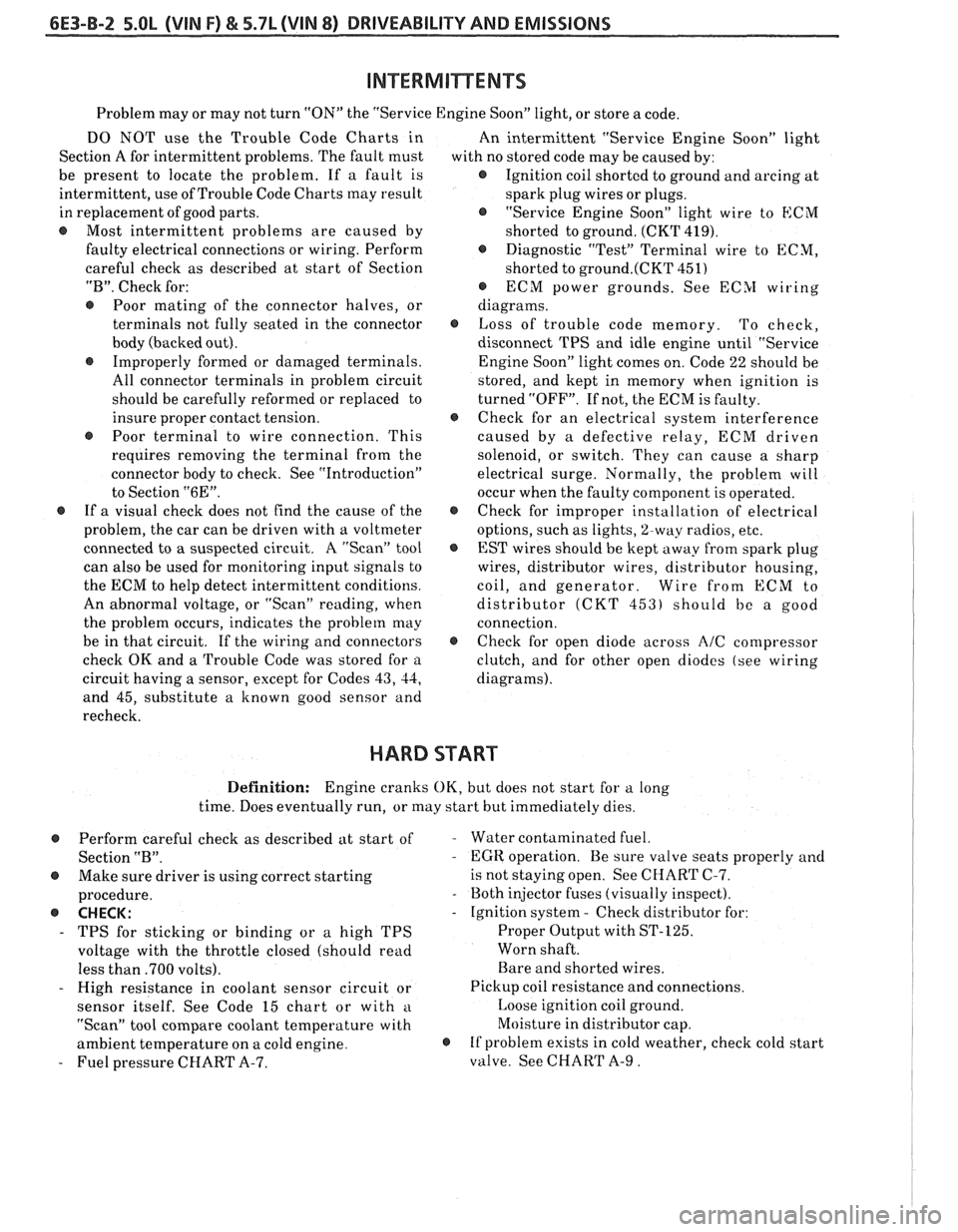
6E3-B-2 5.OL (VIN F) & 5.7L (VIN 8) DRIVEABILITY AND EMISSIONS
Problem may or may not turn "ON" the "Service Engine Soon" light, or store a code.
DO NOT use the Trouble Code Charts in
An intermittent "Service Engine Soon" light
Section A for intermittent problems. The fault must
with no stored code may be caused by:
be present to locate the problem. If a fault is
@ Ignition coil shorted to ground and arcing at
intermittent, use of Trouble Code Charts
may result
spark plug wires or plugs.
in replacement of good parts.
"Service Engine Soon" light wire to
ECM
@ Most intermittent problems are caused by
shorted to ground. (CKT 419).
faulty electrical connections or wiring. Perform
Diagnostic "Test" Terminal wire to ECM,
careful check as described at start of Section
shorted to
ground.(CKT 451)
"B". Check for:
@ ECM power grounds. See ECSI wiring
@ Poor mating of the connector halves, or diagrams.
terminals not fully seated in the connector
@ Loss of trouble code memory. To check,
body (backed out). disconnect TPS and idle engine until "Service
@ Improperly formed or damaged terminals.
Engine Soon" light comes on. Code 22 should be
All connector terminals in problem circuit
stored, and kept in memory when ignition is
should be carefully reformed or replaced to turned "OFF". If not, the ECM is faulty.
insure proper contact tension.
@ Check for an electrical system interference
@ Poor terminal to wire connection. This caused by a defective relay, ECM driven
requires removing the terminal from the
solenoid, or switch. They can cause a sharp
connector body to check. See "Introduction"
electrical surge. Normally, the problem will
to Section
"6E". occur when the faulty component is operated.
@ If a visual check does not find the cause of the @ Check for improper installation of electrical
problem, the car can be driven with a voltmeter
options, such as lights,
%way radios, etc.
connected to
a suspected circuit. A "Scan" tool
EST wires should be kept away from spark plug
can also be used for monitoring input signals to wires, distributor wires, distributor housing,
the ECM to help detect intermittent conditions. coil, and generator. Wire from
ECM to
An abnormal voltage, or "Scan" reading, when distributor
(CKT 453) should be a good
the problem occurs, indicates the problem
may connection.
be in that circuit. If the wiring and connectors
@ Check for open diode across AIC compressor
check OK and a Trouble Code was stored for a
clutch, and for other open diodes (see wiring
circuit having a sensor, except for Codes
43, 44, diagrams).
and 45, substitute a known good sensor and
recheck.
HARD START
Definition: Engine cranks OK, but does not start for a long
time. Does eventually run, or may start but immediately dies.
Perform careful check as described at start of
Section
"B".
@ Make sure driver is using correct starting
procedure.
@ CHECK:
- TPS for sticking or binding or a high TPS
voltage with the throttle closed (should read
less than
.700 volts).
- High resistance in coolant sensor circuit or
sensor itself. See Code 15 chart or with
a
"Scan" tool compare coolant temperature with
ambient temperature on a cold engine.
- Fuel pressure CHART A-7.
- Water contaminated fuel.
- EGR operation. Be sure valve seats properly and
is not staying open. See CHART C-7.
- Both injector fuses (visually inspect).
- Ignition system - Check distributor for:
Proper Output with ST-125.
Worn shaft.
Bare and shorted wires.
Pickup coil resistance and connections.
Loose ignition coil ground.
Moisture in distributor cap.
@ If problem exists in cold weather, check cold start
valve. See CHART A-9.
Page 868 of 1825
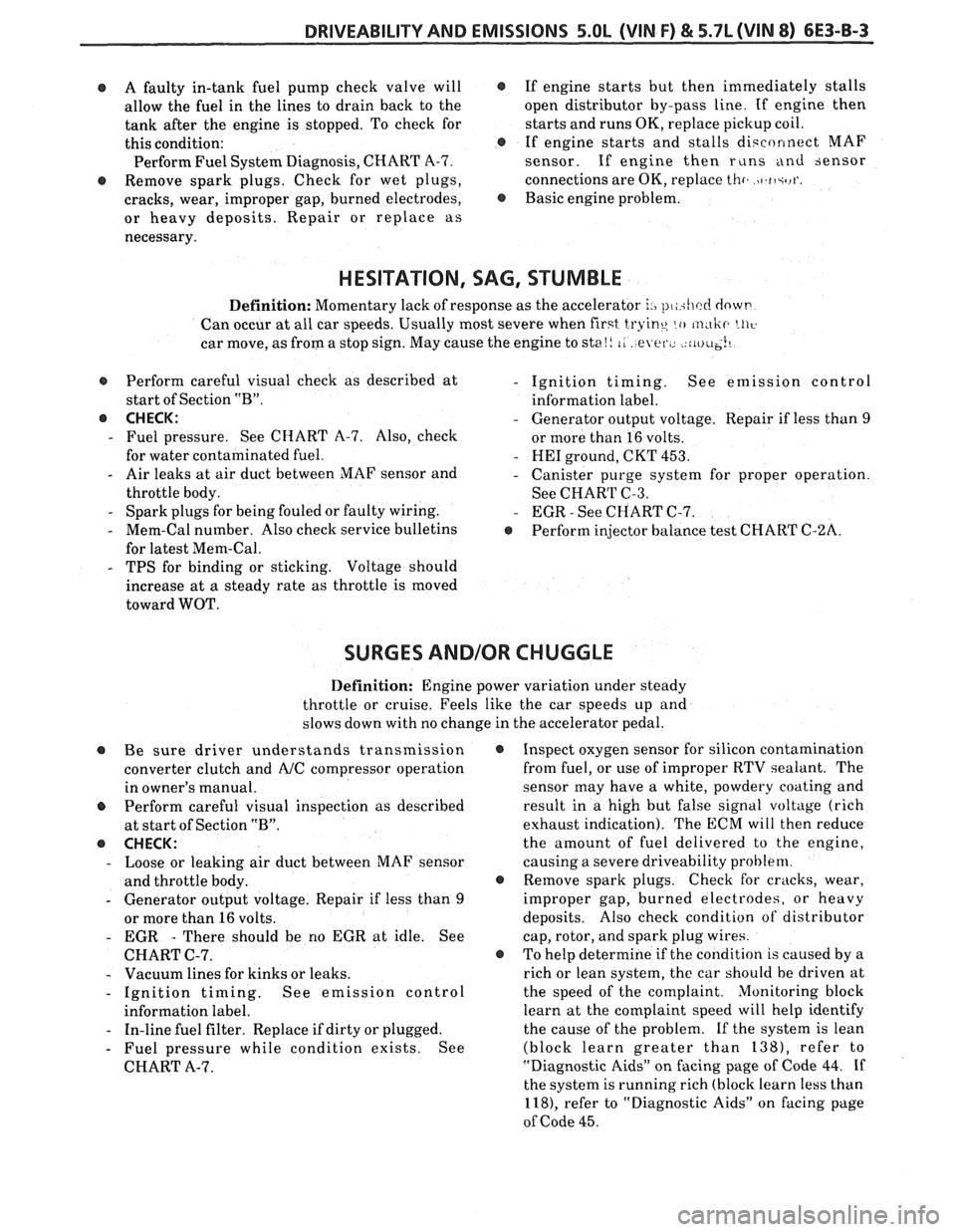
DRIVEABILITY AND EMISSIONS 5.OL (VIN F) & 5.7L (VIN 8) 6E3-8-3
@ A faulty in-tank fuel pump check valve will @
allow the fuel in the lines to drain back to the
tank after the engine is stopped. To check for
this condition:
e
Perform Fuel System Diagnosis, CHART A-7.
@ Remove spark plugs. Check for wet plugs,
cracks, wear, improper gap, burned electrodes,
@
or heavy deposits. Repair or replace as
necessary. If
engine starts but then immediately stalls
open distributor by-pass line. If engine then
starts and runs OK, replace pickup coil.
If engine starts and stalls disconnect MAF
sensor. If engine then
r~lns and sensor
connections are OK, replace
thr. )t.ft+rl'.
Basic engine problem.
HESITATION, SAG, STUMBLE
Definition: Momentary lack of response as the accelerator i., pl,ihcc! dowt-
Can occur at all car speeds. Usually most severe when first tryine, lo m,tlir. LII~.
car move, as from a stop sign. May cause the engine to sta!! 1, e er., riu~~~!~
s Perform careful visual check as described at
start of Section
"B".
@ CHECK:
- Fuel pressure. See CHART A-7. Also, check
for water contaminated fuel.
- Air leaks at air duct between MAF sensor and
throttle body.
- Spark plugs for being fouled or faulty wiring.
- Mem-Cal number. Also check service bulletins
for latest Mem-Cal.
- TPS for binding or sticking. Voltage should
increase at
a steady rate as throttle is moved
toward WOT.
- Ignition timing. See emission control
information label.
- Generator output voltage. Repair if less than 9
or more than 16 volts.
- HE1 ground, CKT 453.
- Canister purge system for proper operation.
See CHART C-3.
- EGR - See CHART C-7.
e Perform injector balance test CHART C-2A.
SURGES AND/OR CHUGGLE
Definition: Engine power variation under steady
throttle or cruise. Feels like the car speeds up and
slows down with no change in the accelerator pedal.
@ Be sure driver understands transmission
converter clutch and
AJC compressor operation
in owner's manual.
Perform careful visual inspection as described
at start of Section
"B".
e CHECK:
- Loose or leaking air duct between MAF sensor
and throttle body.
- Generator output voltage. Repair if less than 9
or more than 16 volts.
- EGR - There should be no EGR at idle. See
CHART C-7.
- Vacuum lines for kinks or leaks.
- Ignition timing. See emission control
information label.
- In-line fuel filter. Replace if dirty or plugged.
- Fuel pressure while condition exists. See
CHART A-7.
@ Inspect oxygen sensor for silicon contamination
from fuel, or use of improper RTV sealant. The
sensor may have a white, powdery coating and
result in a high but false signal voltage (rich
exhaust indication). The ECM will then reduce
the amount of fuel delivered to the engine,
causing a severe driveability problem.
@ Remove spark plugs. Check for cracks, wear,
improper gap, burned electrodes, or heavy
deposits. Also check condition of distributor
cap, rotor, and spark plug wires.
@ To help determine if the condition is caused by a
rich or lean system, the car should be driven at
the speed of the complaint. Monitoring block
learn at the complaint speed will help identify
the cause of the problem.
If the system is lean
(block learn greater than
1381, refer to
"Diagnostic Aids"
on facing page of Code 44. If
the system is running rich (block learn less than
1181, refer to "Diagnostic Aids" on facing page
of Code
45.
Page 869 of 1825
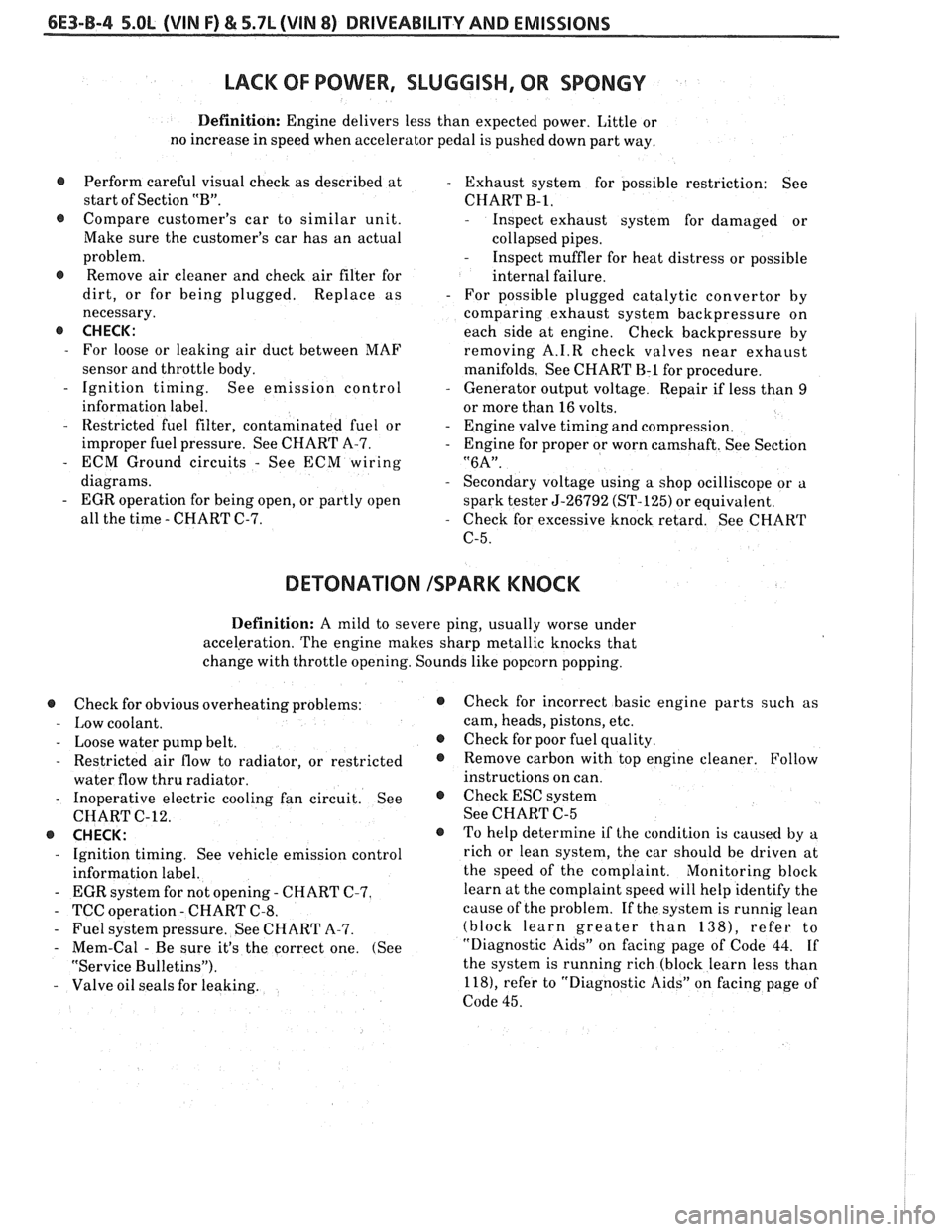
6E3-B-4 5.OL (VIN F) & 5.7L (VIN 8) DRIVEABILITY AND EMISSIONS
LACK OF POWER, SLUGGISH, OR SPONGY
Definition: Engine delivers less than expected power. Little or
no increase in speed when accelerator pedal is pushed down part way.
@ Perform careful visual check as described at
start of Section "B".
@ Compare customer's car to similar unit.
Make sure the customer's car has an actual
problem.
@ Remove air cleaner and check air filter for
dirt, or for being plugged. Replace as
necessary.
@ CHECK:
- For loose or leaking air duct between MAF
sensor and throttle body.
- Ignition timing. See emission control
information label.
- Restricted fuel filter, contaminated fuel or
improper fuel pressure. See CHART A-7.
- ECM Ground circuits - See ECM wiring
diagrams.
- EGR operation for being open, or partly open
all the time
- CHART C-7.
- Exhaust system for possible restriction: See
CHART
B-1.
- Inspect exhaust system for damaged or
collapsed pipes.
- Inspect muffler for heat distress or possible
internal failure.
- For possible plugged catalytic convertor by
comparing exhaust system backpressure on
each side at engine. Check backpressure by
removing
A.1.R check valves near exhaust
manifolds. See CHART
B-1 for procedure.
- Generator output voltage. Repair if less than 9
or more than 16 volts.
- Engine valve timing and compression.
- Engine for proper or worn camshaft. See Section
"6A".
- Secondary voltage using a shop ocilliscope or a
spark tester
5-26792 (ST-125) or equivalent.
- Check for excessive knock retard. See CHART
C-5.
DETONATION ISPARK KNOCK
Definition: A mild to severe ping, usually worse under
acceleration. The engine makes sharp metallic knocks that
change with throttle opening. Sounds like popcorn popping.
@ Check for obvious overheating problems:
- Low coolant.
- Loose water pump belt.
- Restricted air flow to radiator, or restricted
water flow thru radiator.
- Inoperative electric cooling fan circuit. See
CHART C-12.
@ CHECK:
- Ignition timing. See vehicle emission control
information label.
- EGR system for not opening - CHART C-7.
- TCC operation - CHART C-8.
- Fuel system pressure. See CHART A-7.
- Mem-Cal - Be sure it's the correct one. (See
"Service Bulletins").
- Valve oil seals for leaking.
@ Check for incorrect basic engine parts such as
cam, heads, pistons, etc.
@ Checkforpoorfuelquality.
@ Remove carbon with top engine cleaner. Follow
instructions on can.
@ Check ESC system
See CHART C-5
@ To help determine if the condition is caused by a
rich or lean system, the car should be driven at
the speed of the complaint. Monitoring block
learn at the complaint speed will help identify the
cause of the
problem. If the system is runnig lean
(block learn greater than
1381, refer to
"Diagnostic Aids" on facing page of Code
44. If
the system is running rich (block learn less than
1181, refer to "Diagnostic Aids" on facing page of
Code 45.
Page 870 of 1825
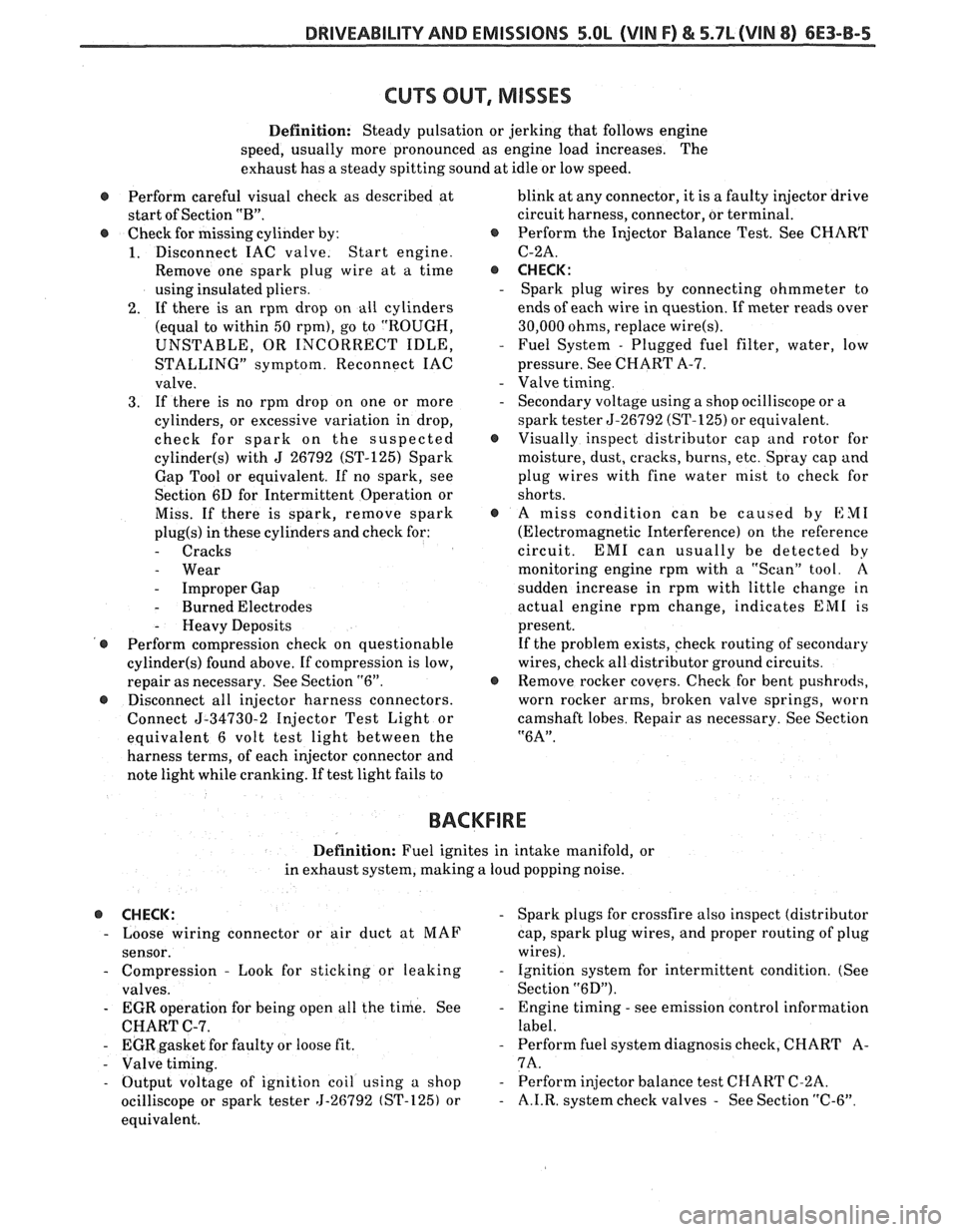
DRIVEABILITY AND EMISSIONS S.OL (VIN F) & 5.7L (VIN 8) 6E3-B-5
Definition: Steady pulsation or jerking that follows engine
speed, usually more pronounced as engine load increases. The
exhaust has
a steady spitting sound at idle or low speed.
@ Perform careful visual check as described at blink
at any connector, it is a faulty injector drive
start of Section
"B". circuit harness, connector, or terminal.
@ Check for missing cylinder by: @ Perform the Injector Balance Test. See CHART
1. Disconnect IAC valve. Start engine. C-2A.
Remove one spark plug wire at a time
@ CHECK:
using insulated pliers. - Spark plug wires by connecting ohmmeter to
2. If there is an rpm drop on all cylinders ends
of each wire in question. If meter reads over
(equal to within
50 rpm), go to "ROUGH, 30,000
ohms, replace wire(s).
UNSTABLE, OR INCORRECT IDLE, - Fuel System - Plugged fuel filter, water, low
STALLING" symptom. Reconnect IAC pressure. See CHART A-7.
valve.
- Valve timing.
3. If there is no rpm drop on one or more - Secondary voltage using a shop ocilliscope or a
cylinders, or excessive variation in drop, spark tester 5-26792 (ST-125)
or equivalent.
check for spark on the suspected
@ Visually inspect distributor cap and rotor for
cylinder(s) with J 26792 (ST-125) Spark moisture, dust, cracks, burns, etc. Spray cap and
Gap Tool or equivalent. If no spark, see plug wires with fine water mist to check for
Section 6D for Intermittent Operation or shorts.
Miss. If there is spark, remove spark
@ A miss condition can be caused by EM1
plug(s) in these cylinders and check for: (Electromagnetic Interference) on the reference
- Cracks circuit. EM1 can usually be detected by
- Wear monitoring engine rpm with a "Scan" tool. A
- Improper Gap sudden
increase in rpm with little change in
- Burned Electrodes actual engine rpm change, indicates EM1 is
- Heavy Deposits present.
@ Perform compression check on questionable If
the problem exists, check routing of secondary
cylinder(s) found above. If compression is low, wires, check
all distributor ground circuits.
repair as necessary. See Section
"6". @ Remove rocker covers. Check for bent pushrods,
@ Disconnect all injector harness connectors. worn
rocker arms, broken valve springs, worn
Connect
5-34730-2 Injector Test Light or camshaft
lobes. Repair as necessary. See Section
equivalent 6 volt test light between the
"6A".
harness terms, of each injector connector and
note light while cranking. If test light fails to
BACKFIRE
Definition: Fuel ignites in intake manifold, or
in exhaust system, making a loud popping noise.
@ CHECK: - Spark plugs for crossfire also inspect (distributor
- Loose wiring connector or air duct at MAF
cap, spark plug wires, and proper routing of plug
sensor. wires).
- Compression - Look for sticking or leaking - Ignition system for intermittent condition. (See
valves. Section
"6D").
- EGR operation for being open all the time. See - Engine timing - see emission control information
CHART C-7. label.
- EGR gasket for faulty or loose fit. - Perform fuel system diagnosis check, CHART A-
- Valve timing. 7A.
- Output voltage of ignition coil using a shop - Perform injector balance test CI-IART C-2A.
ocilliscope or spark tester 5-26792 (ST-125) or
- A.I.R. system check valves - See Section "C-6".
equivalent.
Page 875 of 1825
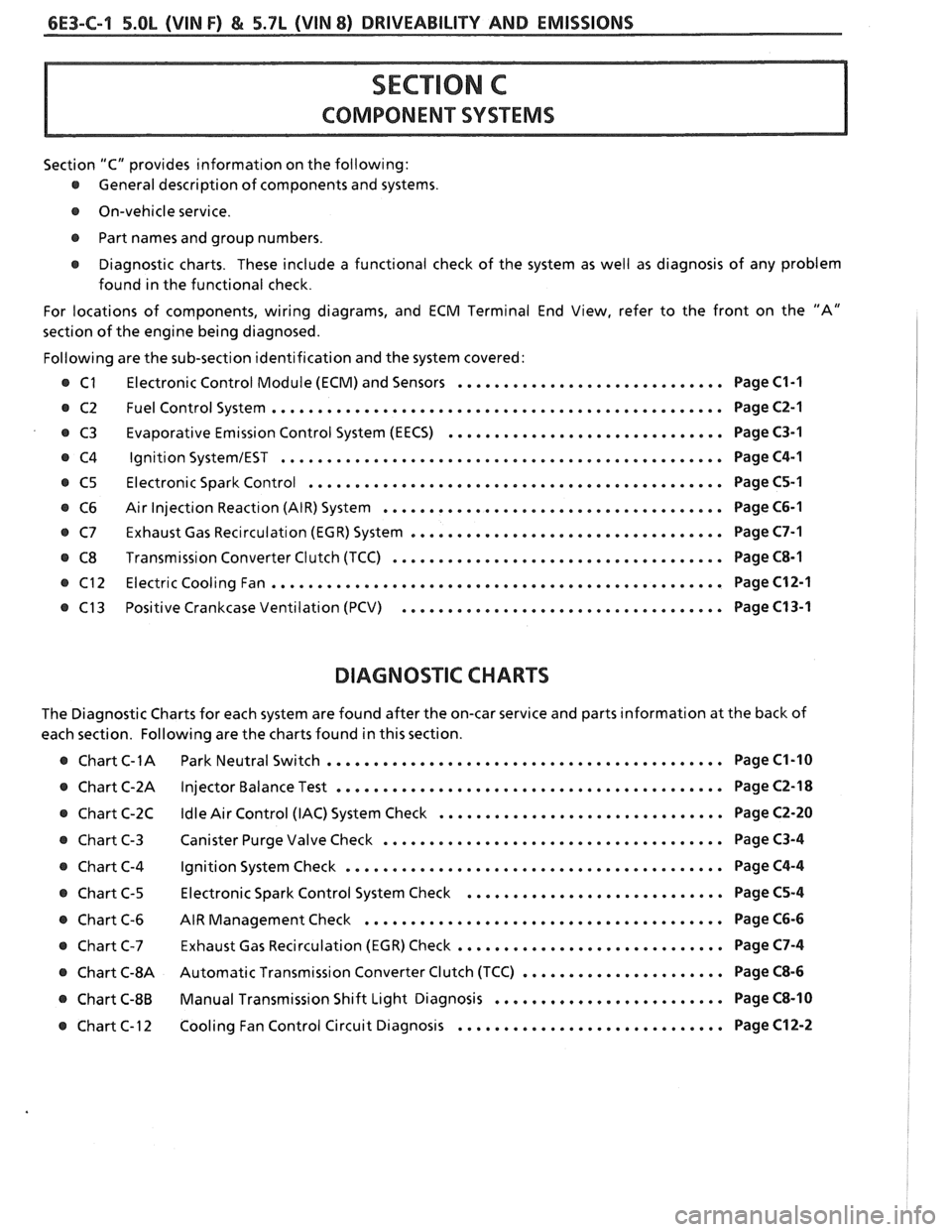
6E3-C-1 5.OL (VIN F) & 5.7L (VIN 8) DRIVEABILITY AND EMISSIONS
COMPONENT SYSTEMS
Section "C" provides information on the following:
@ General description of components and systems .
@ On-vehicle service .
@ Part names and group numbers .
@ Diagnostic charts . These include a functional check of the system as well as diagnosis of any problem
found in the functional check
.
For locations of components, wiring diagrams, and ECM Terminal End View. refer to the front on the "A"
section of the engine being diagnosed
.
Following are the sub-section identification and the system covered:
............................. @ C1 Electronic Control Module (ECM) and Sensors Page C1-I
@ C2 Fuel Control System ................................................. Page C2-I
.............................. @ C3 Evaporative Emission Control System (EECS) Page C3-1
@ C4 Ignition SystemIEST ................................................ Page C4-1
@ C5 Electronic Spark Control ............................................. Page C5-1
..................................... @ C6 Air Injection Reaction (AIR) System Page C6-1
.................................. @ C7 Exhaust Gas Recirculation (EGR) System Page C7-1
.................................... C8 Transmission Converter Clutch (TCC) Page C8-1
................................................. @ C12 Electric Cooling Fan Page C12-1
................................... @ C13 Positive Crankcase Ventilation (PCV) Page C13-1
DIAGNOSTIC CHARTS
The Diagnostic Charts for each system are found after the on-car service and parts information at the back of
each section
. Following are the charts found in this section .
@ Chart C-1A Park Neutral Switch ........................................... Page C1-10
@ Chart C-2A Injector Balance Test .......................................... Page C2-18
@ Chart C-2C Idle Air Control (IAC) System Check ............................... Page C2-20
@ Chart C-3 Canister Purge Valve Check ..................................... Page C3-4
@ Chart C-4 Ignition System Check ......................................... Page C4-4
@ Chart C-5 Electronic Spark Control System Check ............................ Page C5-4
@ Chart C-6 AIR Management Check ....................................... Page C6-6
@ Chart C-7 Exhaust Gas Recirculation (EGR) Check ............................. Page C7-4
@ Chart C-8A Automatic
Transmission Converter Clutch (TCC) ...................... Page C8-6
......................... @ Chart C-8B Manual Transmission Shift Light Diagnosis Page C8-10
@ Chart C-12 Cooling Fan Control Circuit Diagnosis ............................. Page C12-2
Page 877 of 1825

6E3-61-2 S.OL (VIM F) & 5.7L (VIN 8) DRIVEABILITY AND EMISSIONS
The ECM controls output circuits such as the
injector, IAC, cooling fan relay, etc. by controlling the
ground circuit through transistors in the ECM.
INFORMATION SENSORS
Engine Coolant Temperature Sensor
(Figure
Cl-2)
The coolant sensor is a thermistor (a resistor which
changes value based on temperature) mounted in the
engine coolant stream. Low coolant temperature
produces a high resistance (100,000 ohms at
-4O0C/-
40°F), while high temperature causes low resistance
(70 ohms at
130°C/266"F).
The ECM supplies a 5-volt signal to the coolant
sensor through
a resistor in the ECM and measures
the voltage. The voltage will be high when the engine
is cold, and low when the engine is hot. By measuring
the voltage, the ECM knows the engine coolant
temperature. Engine coolant temperature affects
most systems the
ECM controls.
A failure in the coolant sensor circuit should set
either a Code 14 or Code
15. Remember, these codes
indicate
a failure in the coolant temperature circuit,
so proper use of the chart will lead to either repairing
a wiring problem or replacing the sensor, to properly
repair
a problem.
ENGINE COOLANT TEMPERATURE SENSOR
HARNESS CONNECTOR TO
ECM
4-2-85 LOCKING TAE
Figure C1-2 - Engine Coolant Temperature Sensor
Mass Air Flow (MAF) Sensor
(Figure
C1-3)
The mass air flow (MAF) sensor measures the
amount of air which passes through it.
'l'he ECM uses
this information to determine the operating condition
of the engine, to control fuel delivery.
A large
quantity of air indicates acceleration, while a small
quantity indicates deceleration or idle.
The Bosch mass air flow
(MAF) sensor used in this
vehicle is of the hot wire type. Current is supplied to
the sensing wire to maintain a calibrated
temperature, and as air flow increases or decreases
the current will vary. This varying
of current causes a voltage drop within
the meter circuitry which isdirectly proportional to air
mass. The ECM supplies a current limiting 5-volt
source on the signal line, and the MAF sensor pulls
the voltage low (about
.4V) with low air flow and up to
about 5 volts with high air flow such as
WOT. The
voltage drop is then processed by the ECM for
calculating fuel delivery. If the sensor fails, a Code 33
or 34 should be stored in memory.
Due to the sensor's hot wire being exposed to air,
which always contains some contaminants, there can
be deposits form on the sensing wire. This can affect
the accuracy of the meters measurement. To keep the
system functioning properly, the wire is heated to
about
1000°F after engine shut down. This burn-off
cycle is controlled by the ECM, which energizes the
burn-off relay. The ECM will ground the relay
winding after engine shut down, if the engine had
been running a specified amount of time. With the
relay energized, the ECM then monitors the MAF
signal line to determine if the burn-off function took
place. If it didn't, then a Code 36 will be stored and the
"Service Engine Soon" light will come
"ON" the next
time the engine is started.
Figure C1-3 - Mass Air Flow (MAF) Sensor
Manifold Air Temperature (MAT) Sensor
The air temperature sensor (MAT) is a thermistor
(a resistor which changes value based on temperature)
is mounted in the plenum.
Low temperature produces
a high resistance (100,000 ohms at
-40°C/-40°F) while
high temperature causes low resistance (70 ohms at
130°C/266"F).
The ECM supplies a 5-volt signal to the sensor
through a resistor in the ECM and measures the
voltage. 'l'he voltage will be high when the manifold
air is cold, and low when the air is hot. By measuring
the voltage, the ECM knows the manifold air
temperature
Page 892 of 1825
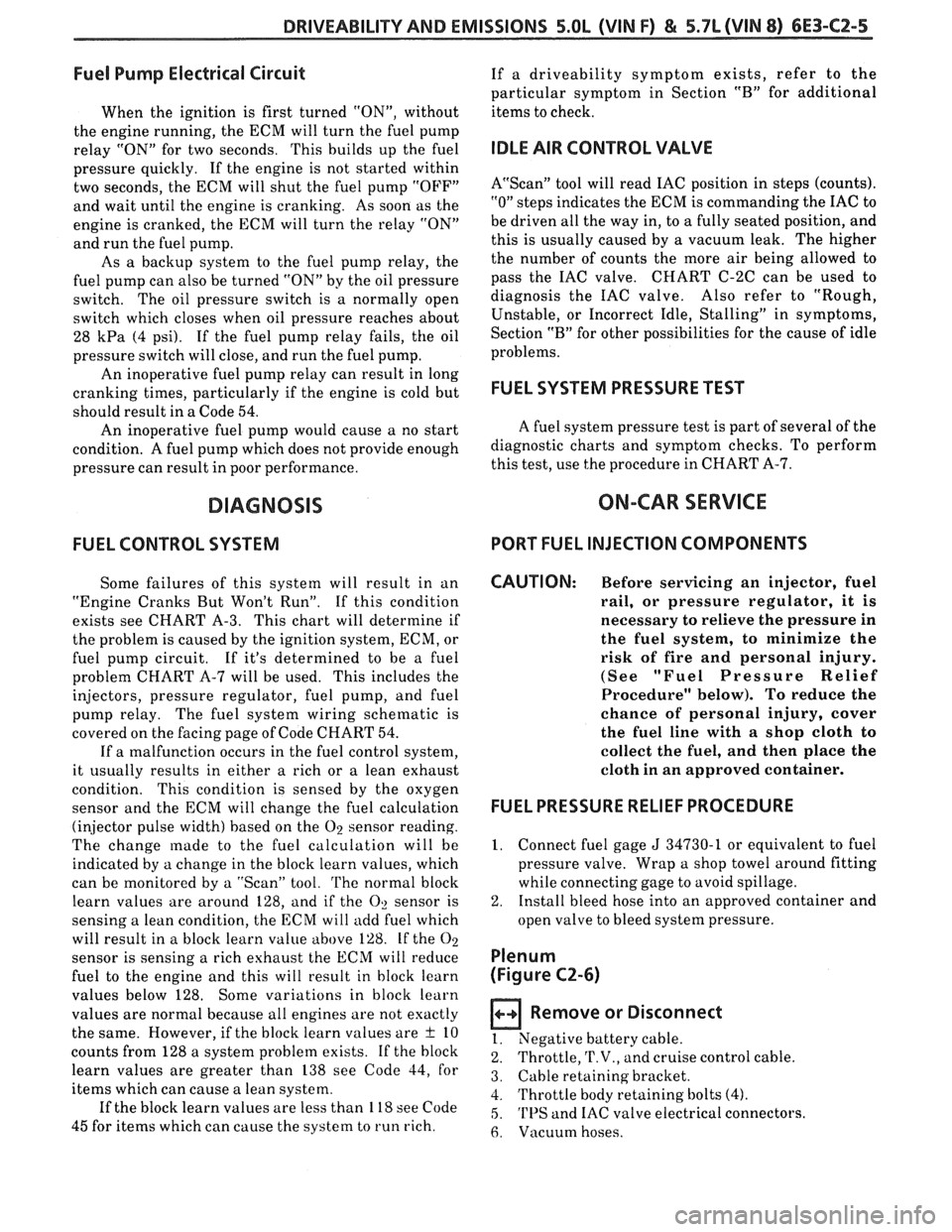
DRIVEABILITY AND EMISSIONS 5.OL (VIN F) & 5.7L (VIN 8) 6E3-C2-5
Fuel Pump Electrical Circuit
When the ignition is first turned "ON", without
the engine running, the ECM will turn the fuel pump
relay "ON" for two seconds.
This builds up the fuel
pressure quickly. If the engine is not started within
two seconds, the ECM will shut the fuel pump "OFF"
and wait until the engine is cranking. As soon as the
engine is cranked, the ECM will turn the relay "ON"
and run the fuel pump.
As
a backup system to the fuel pump relay, the
fuel pump can also be turned "ON" by the oil pressure
switch. The oil pressure switch is a normally open
switch which closes when oil pressure reaches about
28
kPa (4 psi). If the fuel pump relay fails, the oil
pressure switch will close, and run the fuel pump.
An inoperative fuel pump relay can result in long
cranking times, particularly if the engine is cold but
should result in
a Code 54.
An inoperative fuel pump would cause a no start
condition. A fuel pump which does not provide enough
pressure can result in poor performance.
DIAGNOSIS
FUEL CONTROL SYSTEM
Some failures of this system will result in an
"Engine Cranks But Won't Run". If
this condition
exists see CHART A-3. This chart will determine if
the problem is caused by the ignition system, ECM, or
fuel pump circuit. If
it's determined to be a fuel
problem CHART A-7 will be used. This includes the
injectors, pressure regulator, fuel pump, and fuel
pump relay. The fuel system wiring schematic is
covered on the facing page of Code CHART 54.
If a malfunction occurs in the fuel control system,
it usually results in either a rich or
a lean exhaust
condition. This condition is sensed by the oxygen
sensor and the ECM will change the fuel calculation
(injector pulse width) based on the
O2 sensor reading.
The change
made to the fuel calculation will be
indicated by a change in the block learn values, which
can be monitored by a "Scan" tool.
The normal block
learn values are around 128, and if the
O2 sensor is
sensing a lean condition, the EC
M will add fuel which
will result in a block learn value above 128.
If the O2
sensor is sensing a rich exhaust the ECM will reduce
fuel to the engine and this will result in block learn
values below 128. Some variations in block
learn
values are normal because all engines are not exactly
the same. However, if the block learn values are
+ 10
counts from 128 a system problem exists. If the block
learn values are greater than 138 see Code 44, for
items which can cause a lean system.
If the block learn values are less than 118 see Code
45 for items which can cause the system to run rich. If
a driveability symptom exists, refer to the
particular symptom in Section
"B" for additional
items to check.
IDLE AIR CONTROL VALVE
AUScan" tool will read IAC position in steps (counts).
"0" steps indicates the ECM is commanding the IAC to
be driven all the way in, to a fully seated position, and
this is usually caused by a vacuum leak. The higher
the number of counts the more air being allowed to
pass the IAC valve. CHART C-2C can be used to
diagnosis the IAC valve. Also refer to "Rough,
Unstable, or Incorrect Idle, Stalling" in symptoms,
Section "B" for other possibilities for the cause
of idle
problems.
FUEL SYSTEM PRESSURE TEST
A fuel system pressure test is part of several of the
diagnostic charts and symptom checks. To perform
this test, use the procedure in CHART A-7.
ON-CAR SERVICE
PORT FUEL INJECTION COMPONENTS
CAUTION:
Before servicing an injector, fuel
rail, or pressure regulator,
it is
necessary to relieve the pressure in
the fuel system, to minimize the
risk of fire and personal injury.
(See "Fuel Pressure Relief
Procedure" below). To reduce the
chance of personal injury, cover
the fuel line with
a shop cloth to
collect the fuel, and then place the
cloth in an approved container.
FUEL PRESSURE RELIEF PROCEDURE
1. Connect fuel gage J 34730-1 or equivalent to fuel
pressure valve. Wrap a shop towel around fitting
while connecting gage to avoid spillage.
2. Install bleed hose into an approved container and
open valve to bleed system pressure.
Plenum
(Figure
C2-6)
Remove or Disconnect
1. Negative battery cable.
2. Throttle, 'F.V., and cruise control cable.
3. Cable retaining bracket.
4.
'I'hrottle body retaining bolts (4).
5. 'L'l'S and IAC valve electrical connectors.
6. Vacuum hoses.
Page 922 of 1825
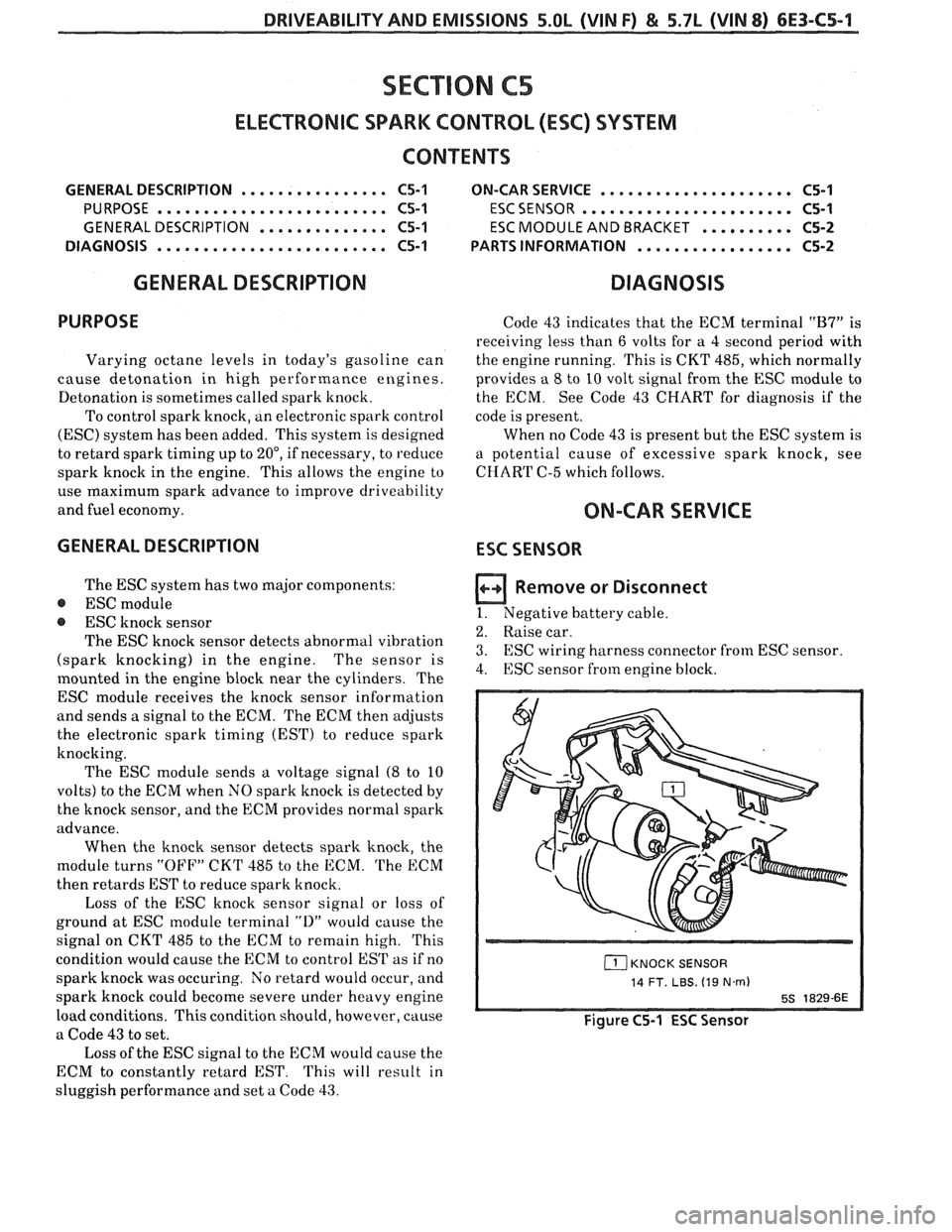
DRIVEABILITY AND EMISSIONS 5.OL (VIN F) & 5.7L (VIN 8) 6E3-C5-1
SECTION C5
ELECTRONIC SPARK CONTROL (ESC) SYSTEM
CONTENTS
GENERAL DESCRIPTION ................ C5-1 ON-CAR SERVICE ..................... C5-1
PURPOSE ......................... C5-1 ESCSENSOR e............e......... C5-1
GENERAL DESCRIPTION .............. C5-1 ESC MODULE AND BRACKET .......... C5-2
DIAGNOSIS
......................... C5-1 PARTS INFORMATION ................. C5-2
GENERAL DESCRIPTION DIAGNOSIS
PURPOSE
Varying octane levels in today's gasoline can
cause detonation in high performance engines.
Detonation is sometimes called spark knock.
To control spark knock, an electronic spark control
(ESC) system has been added. This system is designed
to retard spark timing up to
20°, if necessary, to reduce
spark knock in the engine. This allows the engine to
use maximum spark advance to improve driveability
and fuel economy. Code
43 indicates that the ECM terminal
"B7" is
receiving less than
6 volts for a 4 second period with
the engine running. This is CKT 485, which normally
provides
u 8 to 10 volt signal from the ESC module to
the ECM. See Code 43 CHART for diagnosis if the
code is present.
When no Code 43 is present but the ESC system is
a potential cause of excessive spark knock, see
CI-IART C-5 which follows.
ON-CAR SERVICE
GENERAL DESCRIPTION ESC SENSOR
The ESC system has two major components:
@ ESC module
@ ESC knock sensor
The ESC knock sensor detects abnormal vibration
(spark knocking) in the engine. The
sensor is
mounted in the engine block near the cylinders. The
ESC module receives the knock sensor information
and sends a signal to the ECM. The ECM then adjusts
the electronic spark timing (EST) to reduce spark
knocking.
The ESC module sends a voltage signal
(8 to 10
volts) to the ECM when NO spark knock is detected by
the knock sensor, and the ECM provides normal spark
advance. When the knock sensor detects spark knock, the
module turns
"OFF" CKT 485 to the ECM. The ECM
then retards EST to reduce spark knock.
Loss of the ESC knock sensor signal or loss of
ground at ESC module terminal
"1)" would cause the
signal on CKT 485 to the ECM to remain high.
This
condition would cause the ECM to control EST as if no
spark knock was occuring. No retard would occur,
and
spark knock could become severe under heavy engine
load conditions. This condition should, however, cause
a Code
43 to set.
Loss of the ESC signal to the ECM would cause the
ECM to constantly retard EST. This will result in
sluggish performance and set a Code
43.
Remove or Disconnect
I. Negative battery cable.
2. Raise car.
3. ESC wiring harness connector from ESC sensor.
4. ESC sensor
from engine block.
(1 KNOCK SENSOR
14 FT. LBS. (19 N.m)
5s 1829-6E
Figure C5-1 ESC Sensor